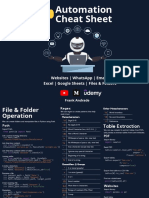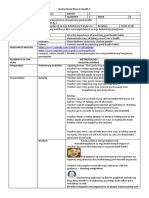0 ratings0% found this document useful (0 votes)
211 viewsCreating a website using Python
Uploaded by
MousaAwadCopyright
© © All Rights Reserved
We take content rights seriously. If you suspect this is your content, claim it here.
Available Formats
Download as DOCX, PDF, TXT or read online on Scribd
0 ratings0% found this document useful (0 votes)
211 viewsCreating a website using Python
Uploaded by
MousaAwadCopyright
© © All Rights Reserved
We take content rights seriously. If you suspect this is your content, claim it here.
Available Formats
Download as DOCX, PDF, TXT or read online on Scribd
You are on page 1/ 2
Creating a website using Python is an exciting endeavor!
Python, known for its
versatility, can indeed be used to build powerful web applications. Let’s break
down the steps to get you started:
1. Understand the Basics:
o Familiarize yourself with HTML and CSS. These are essential for
creating the structure and styling of your website.
o Learn the basics of JavaScript, which is crucial for adding
interactivity and dynamic behavior to your site.
o Get comfortable with the Document Object Model (DOM), as it
allows you to manipulate HTML elements using JavaScript.
2. Choose a Python Framework:
o Python web development is made easier with the use of frameworks.
These frameworks provide a foundation for building websites.
o Two popular Python frameworks are:
Django: Ideal for creating large applications.
Flask: Lightweight and great for smaller, simpler websites.
o Install your chosen framework using the following commands:
For Django: pip install Django
For Flask: pip install flask
3. Set Up Your Project:
o Initialize your project folder based on the framework you’ve chosen.
o For Django, use the command: django-admin startproject
projectname
o For Flask, create a Python file (e.g., app.py) and set up your app.
4. Design Your Website Layout:
o Use HTML to create the structure of your web pages.
o Add CSS for styling and layout design.
o Consider using tools like Figma or Sketch for visual design.
5. Implement Backend Logic:
o Write Python code to handle server-side logic.
o Define routes, views, and controllers based on your project
requirements.
6. Connect to a Database:
o Choose a database system (e.g., SQLite, MySQL, or PostgreSQL).
o Configure your framework to interact with the database.
7. Add User Authentication:
o Implement user registration, login, and authentication features.
o Use libraries like Flask-Login or Django’s built-in authentication.
8. Deploy Your Python Website:
o Choose a hosting provider (e.g., Heroku, AWS, or
PythonAnywhere).
o Deploy your application to a live server.
9. Optimize Website Performance:
o Minimize load times by optimizing images, using caching, and
reducing unnecessary requests.
Remember, building a website involves both coding and understanding the broader
context of web development. Dive in, experiment, and enjoy the process! 🌐✨
You might also like
- 1313-Any One of These Smart Money SecretsNo ratings yet1313-Any One of These Smart Money Secrets4 pages
- smts-2 Theory of Structures by B.C. Punmia Text PDF100% (2)smts-2 Theory of Structures by B.C. Punmia Text PDF497 pages
- Generative AI For Software Developers SyllabusNo ratings yetGenerative AI For Software Developers Syllabus8 pages
- Complete Download (Ebook PDF) Django For APIs: Build Web APIs With Python and Django PDF All Chapters100% (5)Complete Download (Ebook PDF) Django For APIs: Build Web APIs With Python and Django PDF All Chapters51 pages
- Building Your First Automation Bot - SteplistNo ratings yetBuilding Your First Automation Bot - Steplist26 pages
- Riches in Reality Making Real Money in 2024 and BeyondNo ratings yetRiches in Reality Making Real Money in 2024 and Beyond25 pages
- PDF SQL and NoSQL Databases: Modeling, Languages, Security and Architectures for Big Data Management Michael Kaufmann download100% (3)PDF SQL and NoSQL Databases: Modeling, Languages, Security and Architectures for Big Data Management Michael Kaufmann download36 pages
- Gemini for Workspace Prompt Guide October 2024 Digital FinalNo ratings yetGemini for Workspace Prompt Guide October 2024 Digital Final68 pages
- Building A Multi-LLM Chatbot With Langchain - OpenAI and Ollama - by Gayani Parameswaran - MediumNo ratings yetBuilding A Multi-LLM Chatbot With Langchain - OpenAI and Ollama - by Gayani Parameswaran - Medium13 pages
- AI - Artificial Intelligence Program Brochure by Weschool, Bangalore (Welingkar Management Institute)No ratings yetAI - Artificial Intelligence Program Brochure by Weschool, Bangalore (Welingkar Management Institute)9 pages
- How To Get Traffic To Your Website Using Using Just Pinterest or QuoraNo ratings yetHow To Get Traffic To Your Website Using Using Just Pinterest or Quora8 pages
- GenAI A Systematic Survey of Prompting Techniques 1718255319No ratings yetGenAI A Systematic Survey of Prompting Techniques 171825531976 pages
- 5 Examples of Dangerous WhatsApp Phishing Attacks - PhishGridNo ratings yet5 Examples of Dangerous WhatsApp Phishing Attacks - PhishGrid16 pages
- Software Engineering Unit-Iii: School of CSANo ratings yetSoftware Engineering Unit-Iii: School of CSA109 pages
- Psychological Analysis How To Make Money Outsmart The Market Join The Smart Money Circle Adam Sarhan instant downloadNo ratings yetPsychological Analysis How To Make Money Outsmart The Market Join The Smart Money Circle Adam Sarhan instant download67 pages
- Let's Use Python To Scrap Some Online Movies - Videos - by Peng Cao - FreediumNo ratings yetLet's Use Python To Scrap Some Online Movies - Videos - by Peng Cao - Freedium6 pages
- Patterns For Building LLM-based Systems & ProductsNo ratings yetPatterns For Building LLM-based Systems & Products31 pages
- Learning Airtable (First Early Release) Elliott Adams instant download100% (1)Learning Airtable (First Early Release) Elliott Adams instant download68 pages
- IBM MDM 11.6 Installation: Topology, Software Bundles, Prerequisites, Steps and IssuesNo ratings yetIBM MDM 11.6 Installation: Topology, Software Bundles, Prerequisites, Steps and Issues5 pages
- Python Programming: 3 Books in 1: Ultimate Beginneru2019s, Intermediate & Advanced Guide to Learn Python Step-by-Step - Download the ebook today and own the complete version100% (1)Python Programming: 3 Books in 1: Ultimate Beginneru2019s, Intermediate & Advanced Guide to Learn Python Step-by-Step - Download the ebook today and own the complete version55 pages
- High Frequency Trading with C++: A Practical Guide to Dominating the Markets Bisette All Chapters Instant Download100% (7)High Frequency Trading with C++: A Practical Guide to Dominating the Markets Bisette All Chapters Instant Download41 pages
- OceanofPDF.com JavaScript Object-Oriented Programming - Neo D Truman (1)No ratings yetOceanofPDF.com JavaScript Object-Oriented Programming - Neo D Truman (1)137 pages
- Introduction to Mastering Modern Web Technologies with React.js and Ant DesignFrom EverandIntroduction to Mastering Modern Web Technologies with React.js and Ant DesignNo ratings yet
- Instructional Plan in Health 1 Quarter 2 Week 8100% (3)Instructional Plan in Health 1 Quarter 2 Week 83 pages
- Passers List of 3rd Special EPS-ToPIK in Philippines100% (1)Passers List of 3rd Special EPS-ToPIK in Philippines11 pages
- CS 3003 MIS CHAPTER-7 Telecommunications, the Internet, and Wireless TechnologyNo ratings yetCS 3003 MIS CHAPTER-7 Telecommunications, the Internet, and Wireless Technology33 pages
- Phan Hoàng Ngân Giang - 11191465 POHE L Hành 61No ratings yetPhan Hoàng Ngân Giang - 11191465 POHE L Hành 613 pages
- Anaerobic Degradation of Textile Dye Bath Effluent Using Halomonas SPNo ratings yetAnaerobic Degradation of Textile Dye Bath Effluent Using Halomonas SP5 pages
- The Difference Between Real GDP and Nominal GDPNo ratings yetThe Difference Between Real GDP and Nominal GDP2 pages
- Skill Development Plan (Drills For Controlling The Ball) : ChestNo ratings yetSkill Development Plan (Drills For Controlling The Ball) : Chest3 pages
- s.y.b.com - Sem. - III( 2019 Pattern ) - April 2023No ratings yets.y.b.com - Sem. - III( 2019 Pattern ) - April 202384 pages
- Lasers Effects On Enamel For Caries PreventionNo ratings yetLasers Effects On Enamel For Caries Prevention11 pages
- A Study of Emotional Intelligence and Academic Achievement in Medical StudentsNo ratings yetA Study of Emotional Intelligence and Academic Achievement in Medical Students7 pages
- Report Writing: Nature of Research Qualitative Research ReportNo ratings yetReport Writing: Nature of Research Qualitative Research Report7 pages

























































































